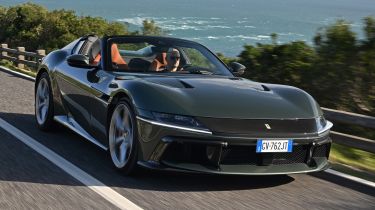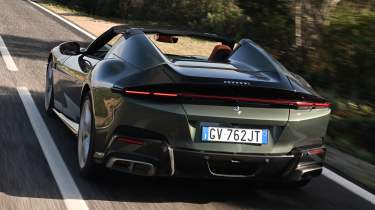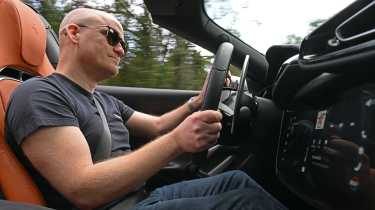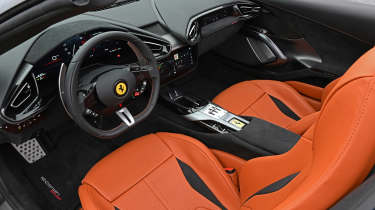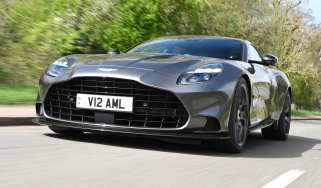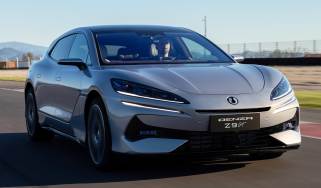New Ferrari 12Cilindri Spider review: a sensational open-top GT
The new Ferrari 12Cilindri Spider combines sensational performance and superb handling

Verdict
With the 12Cilindri Spider, Ferrari can legitimately lay claim to creating the greatest open-top GT car that (quite a lot of) money can buy. Viewed from almost any aspect - from its straight-line performance, its astonishing brakes, the incredible handling that balances with eerily capable ride comfort - the 12Cilindri Spider resoundingly delivers on all of the qualities you’d hope for from a V12 Ferrari. There is one small, but significant exception though, and that’s the engine note. It still sounds thrilling, but the latest emissions regs mean it doesn’t sound as divine as its predecessors.
It's lucky that Italian is such a beautiful language, because it’s fair to say that when it comes to naming their cars, the Italian brands aren’t the most creative. While many of those names sound evocative in the native tongue - Maserati Quattroporte, for example - the ‘four-door’ doesn't have quite the same ring to it, and we doubt the Fiat ‘‘Well Done’ would've been quite so successful from a British brand.
And Ferrari isn’t immune from some very literal naming either. This, the 12Cilindri, is the most recent example. Somehow “doh-di-chee chill-in-dree” sounds a lot more exciting than “12 cylinder”.
This is the Spider variant, literally lifting the lid off the superb V12 machine that we first sampled in Berlinetta form back in October. And losing its roof hasn’t dented its spectacular presence on the road.
Used - available now

2020 Suzuki
SX4 S-Cross
46,548 milesManualPetrol1.4L
Cash £11,997
2020 BMW
X2
44,368 milesAutomaticPetrol2.0L
Cash £14,997
2021 SEAT
Ibiza
18,736 milesManualPetrol1.0L
Cash £14,897
2023 Land Rover
Discovery
13,183 milesAutomaticDiesel3.0L
Cash £57,500While some recent Ferraris, such as the Roma, go for delicate, classic curves, and others go for purely wind tunnel-dictated shapes to maximise downforce (step forward, the wild F80), the 12Cilindri goes for a completely different tactic. Its creators say that “it looks like it’s designed to go into space”.
It’s angular yet curvy; retro yet ultra modern. The black front visor between the headlights might seem like a clear link to another iconic 12-cylinder Ferrari - the 365 GTB/4 Daytona, but Ferrari’s designers tell us that this is more of a happy coincidence than a deliberate decision.
The coupé’s angular rear window panel has been replaced by a pair of buttresses, beneath which a folding metal roof resides. Ferrari chose metal for its superior refinement - and because a space ship wouldn’t have a fabric hood. The weight penalty compared to a soft top is a modest 40kg, according to the brand, and the roof takes just 14 secon ds to open or close, while it can operate at up to 28mph. At 200 litres, the boot is a little down on the Coupé’s 270 litres, and structural rigidity has taken a slight knock, too. While the company wouldn’t quote a figure relative to the coupé, it states that the 12Cilindri Spider is 15 per cent more rigid than its predecessor, the 812 GTS.
Regardless of where you rank this among Ferrari’s greatest designs, what’s absolutely not up for debate is that in the light of day and among everyday traffic, Flavio Manzoni’s design has a spectacular presence. Long, low and sleek, it looks like it’s been beamed into our reality from the future.
Get into the nitty-gritty of the mechanical tech, and there’s certainly a lot of sci-fi features. First, the aerodynamics: Ferrari is always keen to avoid big wings or spoilers which would detract from the car’s shape, so active aero is employed. A pair of winglets at each end of the black panel that covers the boot rise quickly under heavy braking or hard cornering to generate more downward pressure over the rear axle.
Ferrari’s latest iteration of its four-wheel steering system – an ABS-Evo brake-by-wire set-up that can anticipate how much friction is at each tyre’s disposal based on road conditions, steering angle and speed, braking each wheel individually to suit – plus an eight-speed dual clutch gearbox that shifts 30 per cent quicker than the 812’s seven-speed transmission are both new to Ferrari’s flagship.
However, the most important detail in that mechanical make-up remains resolutely and delightfully old school. Ferrari believes that a V12 is a key part of its identity, and as such it has vowed to continue building cars with them for as long as it’s possible to do so.
A range of upgrades are introduced to the front-mid-mounted 6.5-litre V12 compared with the unit fitted to the 812. Titanium conrods, aluminium-alloy pistons and a rebalanced crank all contribute to reduced internal masses. Formula One-derived sliding finger followers, actuated by the camshafts, act on the valve springs via hydraulic tappets to reduce frictional losses. Ferrari has even mapped the torque curves (especially in third and fourth gears) in order to deliver a power delivery that encourages the driver to use those revs.
And rev it can – the result of all this on-paper is nothing short of staggering. The 12Cilindri pumps out a staggering 819bhp, which is achieved just 250rpm short of its stratospheric 9,500rpm red line.
It’s a limit that, on the road, might initially seem intimidating to exploit, especially during the unseasonally heavy downpours of our Portuguese test route. Wind it up through the first gear or two before shifting up at around 7,000rpm - only to realise that you haven’t even reached its peak torque of 678Nm, which turns up at 7,250rpm. Those upshifts engage near-instantly though, and the gearbox is superb; from its smoothness pottering around in traffic to its response at higher speeds and even the feel of its steering wheel-mounted paddles, it’s one of the best in any car right now.
Build a bit of confidence in the damp, and squeeze the throttle further, and the 12Cilindri reveals a remarkable talent. How can it be possible to make a 819bhp so approachable to drive? Even on greasy roads, you realise that you can drive it harder and harder. Of course, you still need to finesse your right foot so things don’t get out of hand, but it’s possible to introduce wheelspin in a straight line - or a little sideways slip through the corners - without your palms going all clammy.
Technology is at its best when its intervention is so delicate that you hardly notice that it’s doing anything at all, and that’s the case with the stability-control systems here. There are no abrupt cuts in torque, just a set-up that helps the driver make the most of their own talents.
Of course, electrical systems can only do so much, because the underpinnings must be fundamentally brilliant to make this chassis so exploitable. The four-wheel-steering system lends the 12Cilindri incredible response on turn-in and huge grip mid-corner, plus a naturally, progressive feel as a squeeze of the right pedal pushes the rear end through the exit. It’s so well balanced that you can trust it so quickly, even in the rain, where some less powerful performance cars begin to fall apart.
That it can do all of this while riding better than most family hatchbacks is even more staggering. This isn’t an out-and-out track weapon after all; Ferrari has designed the 12Cilindri to be its ultimate GT car, and it really is. Ride comfort at all speeds is brilliant, and we’d struggle to find a better long-distance cruiser on sale today. Just make sure you keep the roof up, because things get a bit noisy at motorway speeds otherwise. The cabin is a comfortable place to be, although it's a shame that the starter button is touch-sensitive - it lacks the theatre of a big physical button when it comes to waking that V12 into life.
As the roads dry, we finally summon up the courage to press the pedal all the way to the floor and use all 819bhp. The engine response is staggering. The revs flare up to 9,500rpm as the next ratio hits home, with barely a slight let-up in shove. Explore those revs in subsequent gears on the road more than twice, and you’ll likely reach some quite naughty speeds. Ferrari states that 0-62mph is dispatched in 2.95 seconds, and 0-124mph takes 8.2 seconds. We wouldn't dream of arguing with either number. Fortunately, the brakes are equally as incredible, both in their power and feedback.
Ironically for a model that is named after its engine configurations, the one aspect of the car that ever-so-slightly takes the shine of the experience is that V12 engine. Clearly a lot has been done to try to make the 12Cilindri sound as exciting as possible; resonators ahead of the throttle bodies pipe the engine note into the car, while Ferrari has optimised the intake and exhaust tuning to ensure the noise is as ‘emotional’ as possible.
However, all of this, plus the engine developments covered earlier, are fitted in response to what’s going on further down the process. In a battle to comply with ever-tightening emissions regulations (particularly in American and Chinese markets), Ferrari has fitted catalytic converters which it says are the most advanced of their type. But they do take the edge off the noise.
Now don’t get us wrong, this car still sounds very special - it’s spine-tingling at 9,500rpm - but compared with the raw edge of its predecessor, things just appear a touch artificial at times. Given the exhaust filters are to blame, we’re sure there will be an aftermarket exhaust system (or several) coming to market that’ll sort that out in no time at all - then there will be almost nothing to fault.
| Model: | Ferrari 12Cilindri Spider |
| Price: | £366,500 |
| Engine: | 6.5-litre V12 petrol |
| Power/torque: | 819bhp/678Nm |
| Transmission: | Eight-speed automatic, rear-wheel drive |
| 0-62mph: | 2.95 seconds |
| Top speed: | More than 211mph |
| Economy: | TBC |
| CO2: | TBC |
| Size (L/W/H): | 4,733/2,176/1,292mm |
| On sale: | Now |

